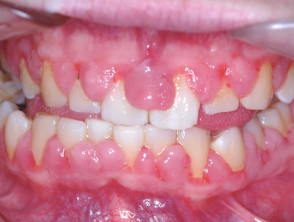
Inflammatory response to nickel is considered as type IV hypersensitivity and is manifested as nickel allergic contact stomatitis but its aetiology has not yet clearly been defined ( Holmstrup, 1999 Vanarsdall, 2000). Such manifestations are usually associated with the inflammatory response induced by the corrosion of orthodontic appliances, and major emphasis has been placed on nickel ( Eliades et al., 2003).

Orthodontic treatment may initiate oral clinical manifestations, such as labial desquamation ( Lindsten and Kurol, 1997), multiform erythema ( Starkjaer and Menné, 1990), gingivitis ( Shelley, 1981), and gingival enlargement ( Bishara et al., 1993 Genelhu et al., 2005 Kouraki et al., 2005). In the limitations of this study, it is plausible that the effect of a continuing low-dose nickel release to epithelium is the initiating factor of gingival overgrowth induced by orthodontic treatment. The results did not show any difference in nickel concentration between the study and control gingiva tissue samples, but histological analysis demonstrated an increase in epithelial thickness and a significant increase ( P = 0.031, 0.02, 0.02) in epithelial cell proliferation in response to low-dose nickel concentrations, with a toxic response to a higher dose. Mann–Whitney U-test, analysis of variance, and Tukey's test were used in the statistical analyses. To analyse the effect of nickel on epithelial cell proliferation, four different nickel concentrations (0.5, 2, 5, and 10 μg) were incubated with keratinocyte cells for 11 days. The tissues removed from hyperplastic areas during gingivectomy were also used for histological analysis. The amount of nickel in the gingival tissue samples was analysed using the atomic absorption spectrometry technique. Hyperplastic and healthy gingiva samples were collected from the same patients. Ten patients receiving orthodontic therapy (eight females and two males, mean age 15.4 years) were included in the study. The nickel concentration in gingival tissues with and without overgrowth, histopathology of gingival overgrowths, and epithelial cell proliferation response to different nickel concentrations were analysed. Black patients specifically face a triple threat with higher rates of hypertension and its complications, guidelines that limit therapeutic options for first-line treatment, and high rates of poverty limiting access to dental care.The aim of this study was to investigate the role of nickel in orthodontic treatment-induced gingival hyperplasia. Patients in poverty are at much greater risk for this adverse outcome due to limited access to dental care.

Dental changes also cause pain, financial hardship, and psychosocial damage. Unchecked, gingival overgrowth can lead to tooth movement and eventual loss. We also expand the understanding of this phenomenon by exploring the serious health justice implications of this adverse effect.

We review the pathophysiology, prevalence, and clinical management of gingival overgrowth.

Here we present a case report of a significant adverse event due to the use of amlodipine-gingival overgrowth. In the US, over 70 million prescriptions for amlodipine are written annually. Among the first-line medications for hypertension are calcium channel blockers, such as amlodipine. As primary care clinicians, nurse practitioners help patients control their blood pressure through lifestyle coaching and medication. Hypertension is a leading cause of death and disability in the United States and worldwide.


 0 kommentar(er)
0 kommentar(er)
